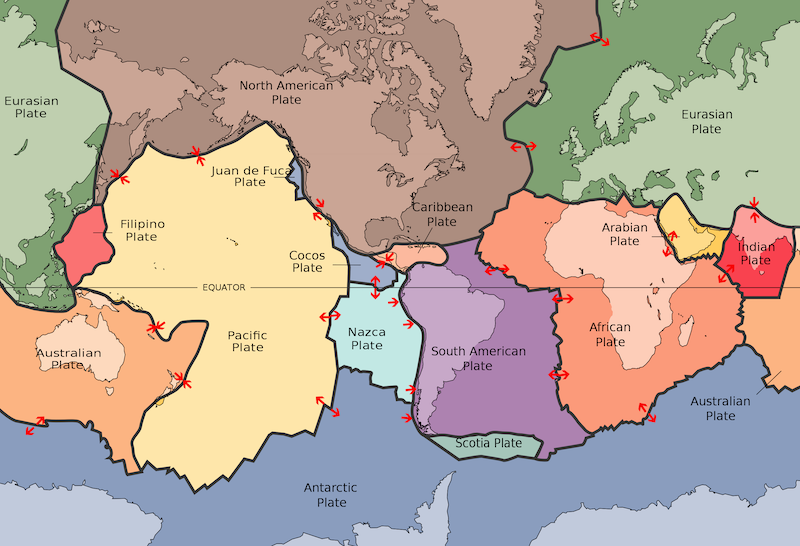
How long ago did plate tectonics – the slow movement of great land plates in Earth’s outer shell – begin? We don’t know for certain. But estimates range from 4 billion years ago to as recently as 800 million years ago. On April 21, 2022, researchers at Harvard University said they’ve confirmed 3.8 billion years ago as the time when plate tectonics began. This new estimate is based on a study of ancient zircon crystals found in South Africa.
The crystals contain the earliest known evidence of subduction, the process by which one land plate on Earth’s surface dives under another.
The researchers published their new peer-reviewed findings in AGU Advances on April 21, 2022.
Transition to plate tectonics 3.8 billion years ago
So what is plate tectonics, anyway? It is a geological process where the Earth’s crust and the top layer of the mantle have broken up into separate massive and rigid plates. These plates move around, albeit slowly, on top of a viscous – thick or sticky – layer of the mantle. This movement, driven by heat from the Earth’s core deep down, fuels a variety of geological processes on or close to the surface, including earthquakes, volcanoes and mountain-building.
Previously, the Earth’s crust was rigid and immobile. But then, during the transition to plate tectonics, these new processes took over. Now, Earth’s crust is dynamic and active. Scientists think that plate tectonics helped Earth to become more habitable, assisting in the evolution of simple microorganisms to more complex lifeforms. Today, plate tectonics help Earth remain habitable (more on that below).
According to the new study, the transition period began about 3.8 billion years ago. Until now, however, it has been difficult to detrmine just when plate tectonics started. Somewhat ironically, this is largely due to plate tectonics itself. The ongoing recycling of Earth’s surface, due to the plates flowing under each other, has erased much of the geological record from when Earth was young, during the first 500 million years or so. This period is known as the Hadean eon. As a result, clues as to the geological processes during this time have been largely wiped out.

As Nadja Drabon, a geologist at Harvard University and lead author, stated:
The Hadean Earth is this big mystery box.
New clues in tiny crystals
So then how did the researchers determine the time for when plate tectonics started? The answer is in tiny microscopic crystals called zircon crystals. Drabon and her colleagues discovered them in 2018 in a block of crust in the Barberton Greenstone Belt in South Africa. A chronological series of 33 microscopic zircon crystals were found altogether. They formed at various times over 800 million years, from 4.15 to 3.3 billion years ago.
Why is this significant? Zircon crystals are fairly common, in general, but are very rare from the Hadean eon. In fact, zircon crystals from 4 to 4.56 billion years ago have only been found in 12 locations on Earth. In addition, less than three crystals have typically been unearthed at each location. That is rare, indeed!
Similarities to modern subduction zones
By examining hafnium isotopes and other trace elements in the crystals, the researchers found clues as to the geological conditions at the time they formed. Analysis of the crystals showed a difference from before 3.8 billion years ago and after. The ones formed 3.8 billion years ago, and later, showed evidence for pressures and melting similar to that found in modern subduction zones.

Since subduction zones are an integral part of plate tectonics, this suggests that plate tectonics began during this period. Or at least the initial beginning stages of plate tectonics. Drabon said:
When I say plate tectonics, I’m specifically referring to an arc setting, when one plate goes under another and you have all that volcanism; think of the Andes, for example, and the Ring of Fire. At 3.8 billion years there is a dramatic shift where the crust is destabilized, we have new rocks forming and we see geochemical signatures becoming more and more similar to what we see in modern plate tectonics.
In comparison, the analysis of older zircon crystals supported previous studies that Earth’s crust – or protocrust – was inert and stable. This crust remained basically unchanged for at least 600 million years.
Other locations
The zircon crystals in South Africa are not the only ones, however. Analysis of ones from other locations also supports the conclusions about the start date of plate tectonics. As Drabon noted:
We see evidence for a significant change on the Earth around 3.8 to 3.6 billion years ago and evolution toward plate tectonics is one clear possibility.

The results also pose another question. Was this change in Earth’s crust global, or in more isolated pockets? Drabon thinks the crystals point to the beginnings of a global change. The process may have started in different pockets in various locations, before becoming global. Drabon said:
The record we have for the earliest Earth is really limited, but just seeing a similar transition in so many different places makes it really feasible that it might have been a global change in crustal processes. Some kind of reorganization was happening on Earth.
Plate tectonics help sustain life
As noted previously, plate tectonics also play a big role in helping to keep Earth habitable. The process is kind of like a thermostat for the entire planet. It helps prevent temperatures in the atmosphere from becoming too hot or too cold. How does it do that?
Plate tectonics releases volcanic gases from below the surface, as well as producing new silicate rock. This, in turn, consumes large amounts of carbon dioxide in the atmosphere. This cycle prevents large temperature swings due to too much or too little greenhouse gas. As Drabon noted:
Without all of the recycling and new crust forming, we might be going back and forth between boiling hot and freezing cold. It’s kind of like a thermostat for the climate.
Effects of no plate tectonics
We see these kinds of effects elsewhere as well. Mars, with its extremely thin carbon dioxide atmosphere, is on average much colder than Earth. Venus, however, has a deep, thick atmosphere of carbon dioxide, which locks in heat and is the reason the planet is so scorching hot on its surface.
It is not yet known if Venus had comparable plate tectonics in its distant past, when the planet was cooler and more hospitable. There is, however, evidence for pack ice tectonics on Venus. These are blocks of the planet’s crust that may be moveable. It’s not quite the same as regular plate tectonics, but similar.
There is some evidence for the possible rudimentary beginnings of plate tectonics on Mars, but it was not nearly as advanced as on our own planet. The lack of advanced plate tectonics is likely mostly due to the planet’s small size.

Bottom line: A new study of ancient zircon crystals found in South Africa and other locations shows that plate tectonics on Earth began about 3.8 billion years ago.
The post Plate tectonics clues found in ancient crystals first appeared on EarthSky.
0 Commentaires